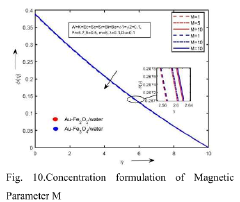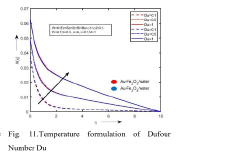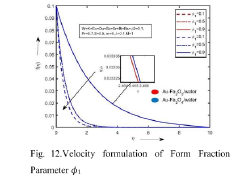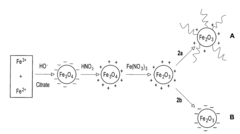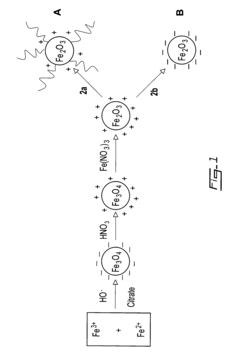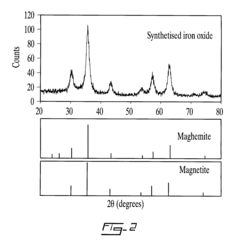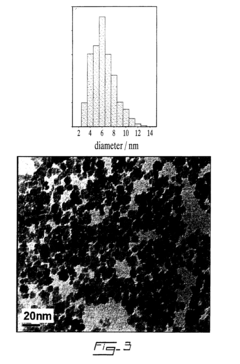Future Trends of Ferrofluid in Transformational Urban Development
Ferrofluid Evolution and Urban Goals
Ferrofluids, first developed in the 1960s by NASA, have evolved significantly over the past six decades. These unique magnetic liquids, composed of nanoscale ferromagnetic particles suspended in a carrier fluid, have transitioned from space exploration applications to a wide array of terrestrial uses. The evolution of ferrofluids has been marked by advancements in synthesis techniques, particle size control, and carrier fluid optimization, leading to enhanced stability and performance characteristics.
In the context of transformational urban development, ferrofluids present exciting possibilities for innovative solutions to urban challenges. The primary goal in this realm is to leverage the unique properties of ferrofluids to create smart, responsive, and sustainable urban environments. This includes developing adaptive infrastructure, energy-efficient systems, and novel architectural designs that can respond dynamically to changing environmental conditions and urban needs.
One key objective is to integrate ferrofluids into building materials and structures to enhance their resilience and adaptability. This could lead to self-healing buildings, temperature-regulating facades, and vibration-dampening systems that improve structural integrity during seismic events. Another goal is to utilize ferrofluids in urban water management systems, potentially revolutionizing water purification, distribution, and waste treatment processes in cities.
Energy efficiency and sustainability are also central to the urban development goals involving ferrofluids. Researchers aim to develop ferrofluid-based energy harvesting systems that can capture and convert ambient energy from urban environments into usable electricity. This could include harnessing vibrations from traffic or buildings, or even capturing thermal energy from urban heat islands.
Furthermore, there is a growing interest in using ferrofluids to create dynamic public spaces and interactive urban art installations. These applications not only serve aesthetic purposes but also have the potential to engage citizens and promote community interaction in novel ways. The goal is to transform static urban landscapes into responsive, living environments that adapt to the needs and moods of city dwellers.
As urban populations continue to grow and cities face increasing environmental and resource challenges, the evolution of ferrofluid technology aligns with broader urban development goals of creating more resilient, efficient, and livable cities. The future trajectory of ferrofluid research and development in urban contexts is focused on scaling up laboratory successes to practical, large-scale applications that can be integrated seamlessly into the urban fabric.
Urban Market Demand Analysis
The urban market demand for ferrofluid technology in transformational urban development is rapidly evolving, driven by the increasing need for innovative solutions in smart city infrastructure, sustainable urban planning, and advanced transportation systems. As cities worldwide face challenges related to population growth, resource management, and environmental sustainability, ferrofluid applications offer unique opportunities to address these issues.
In the realm of smart city infrastructure, ferrofluid-based sensors and actuators are gaining traction for their ability to enhance the performance of various urban systems. These applications include adaptive traffic management, where ferrofluid-based devices can provide real-time data on traffic flow and road conditions, enabling more efficient traffic control and reducing congestion. The market for such smart traffic solutions is projected to grow significantly in the coming years, as cities seek to optimize their transportation networks.
Sustainable urban planning is another area where ferrofluid technology is finding increasing demand. Ferrofluid-based cooling systems for buildings and urban heat management solutions are attracting attention from city planners and developers. These systems offer improved energy efficiency and reduced environmental impact compared to traditional cooling methods. As cities strive to meet sustainability goals and reduce their carbon footprint, the market for such innovative cooling solutions is expected to expand rapidly.
Advanced transportation systems represent a significant market opportunity for ferrofluid technology. Magnetic levitation (maglev) trains, which utilize ferrofluids in their suspension systems, are gaining interest as a high-speed, energy-efficient alternative to conventional rail transport. Several major cities are exploring or implementing maglev projects, indicating a growing market for ferrofluid applications in urban transportation infrastructure.
The urban water management sector is also showing increased demand for ferrofluid-based solutions. Ferrofluid technology can be applied in water purification systems, offering more efficient and cost-effective methods for treating urban wastewater and ensuring clean water supply. As water scarcity becomes a pressing issue in many urban areas, the market for advanced water treatment technologies is expected to grow substantially.
In the field of urban energy management, ferrofluid applications in power generation and distribution systems are attracting attention. Ferrofluid-based transformers and power transmission components offer improved efficiency and reliability, addressing the growing energy demands of urban areas. The market for such advanced energy infrastructure solutions is projected to expand as cities upgrade their power grids to accommodate renewable energy sources and smart grid technologies.
Urban security and surveillance systems represent another potential growth area for ferrofluid technology. Ferrofluid-based sensors and imaging devices can enhance the capabilities of urban security networks, offering improved detection and monitoring capabilities. As cities invest in comprehensive security solutions, the demand for advanced sensing technologies is expected to increase.
Ferrofluid Tech Challenges
Despite the promising potential of ferrofluids in urban development, several significant technical challenges persist, hindering their widespread adoption and implementation. One of the primary obstacles is the long-term stability of ferrofluids. When exposed to various environmental factors such as temperature fluctuations, magnetic fields, and oxidation, ferrofluids tend to degrade over time, losing their unique properties. This instability limits their practical applications in urban infrastructure and systems that require prolonged functionality.
Another critical challenge lies in the precise control and manipulation of ferrofluids at larger scales. While ferrofluids can be easily controlled in small-scale laboratory settings, translating this control to urban-scale applications presents significant difficulties. The complex interplay between magnetic fields, fluid dynamics, and environmental factors makes it challenging to achieve consistent and predictable behavior in real-world scenarios.
The cost-effectiveness of ferrofluid production and implementation also poses a substantial hurdle. Current manufacturing processes for high-quality ferrofluids are often expensive and not easily scalable, making their widespread use in urban development economically unfeasible. Additionally, the integration of ferrofluid-based systems into existing urban infrastructure requires significant investment and retrofitting, further increasing the overall cost.
Environmental concerns and potential health risks associated with ferrofluids present another set of challenges. The long-term effects of ferrofluid exposure on ecosystems and human health are not yet fully understood, raising questions about their safety in urban environments. Addressing these concerns requires extensive research and the development of robust safety protocols.
The lack of standardization in ferrofluid technology also impedes its adoption in urban development. Without established industry standards and best practices, it becomes difficult for urban planners and developers to incorporate ferrofluid-based solutions confidently. This absence of standardization also hampers interoperability between different ferrofluid systems and components.
Lastly, the interdisciplinary nature of ferrofluid applications in urban development necessitates collaboration between experts from various fields, including materials science, civil engineering, urban planning, and environmental studies. Bridging the knowledge gap between these disciplines and fostering effective collaboration remains a significant challenge in advancing ferrofluid technology for urban applications.
Current Ferrofluid Solutions
01 Composition and preparation of ferrofluids
Ferrofluids are colloidal suspensions of magnetic nanoparticles in a carrier fluid. They are typically composed of magnetite or other ferromagnetic materials coated with a surfactant to prevent agglomeration. The preparation process involves careful control of particle size and distribution to maintain stability and magnetic properties.- Composition and preparation of ferrofluids: Ferrofluids are colloidal suspensions of magnetic nanoparticles in a carrier fluid. They are typically composed of magnetite or other ferromagnetic materials coated with a surfactant to prevent agglomeration. The preparation process involves careful control of particle size and distribution to maintain stability and magnetic properties.
- Applications in sealing and lubrication: Ferrofluids are widely used in sealing and lubrication applications, particularly in rotating shaft seals. They provide a liquid barrier that can be controlled by magnetic fields, offering advantages in terms of low friction, long life, and the ability to operate in vacuum environments.
- Thermal management and cooling systems: Ferrofluids are employed in thermal management solutions, particularly for electronic devices. Their unique properties allow for efficient heat transfer and cooling when subjected to magnetic fields, making them valuable in applications such as computer cooling systems and power electronics.
- Damping and vibration control: The viscoelastic properties of ferrofluids make them useful in damping applications. They can be used to control vibrations in mechanical systems, providing adaptive damping that can be tuned by adjusting the applied magnetic field strength.
- Sensing and measurement applications: Ferrofluids are utilized in various sensing and measurement devices. Their response to magnetic fields and ability to change shape or position makes them suitable for applications such as accelerometers, inclinometers, and pressure sensors. They can also be used in magnetic field visualization and educational demonstrations.
02 Applications in sealing and lubrication
Ferrofluids are widely used in sealing and lubrication applications, particularly in rotating shaft seals. They provide a liquid barrier that can be controlled by magnetic fields, offering advantages in terms of low friction, long life, and the ability to operate in vacuum environments.Expand Specific Solutions03 Thermal management and cooling systems
Ferrofluids are employed in thermal management solutions, particularly in electronic cooling systems. Their unique properties allow for efficient heat transfer and the ability to be directed by magnetic fields, making them useful in targeted cooling applications for components like processors and power electronics.Expand Specific Solutions04 Damping and vibration control
The viscoelastic properties of ferrofluids make them suitable for damping applications. They can be used in shock absorbers, vibration isolators, and other mechanical systems to control unwanted motion and absorb energy, improving system stability and performance.Expand Specific Solutions05 Sensing and measurement applications
Ferrofluids are utilized in various sensing and measurement devices. Their response to magnetic fields and ability to change shape or position makes them useful in applications such as accelerometers, inclinometers, and pressure sensors. They can also be used in magnetic field visualization and measurement tools.Expand Specific Solutions
Key Urban Tech Companies
The ferrofluid market in urban development is in an early growth stage, with increasing applications in smart infrastructure and sustainable technologies. Market size is expanding as more cities adopt ferrofluid-based solutions, though still relatively niche. Technologically, ferrofluids are advancing rapidly, with companies like Merck Patent GmbH and Chongqing University leading research into novel formulations and applications. While established players like Koninklijke Philips NV are exploring ferrofluid integration in urban systems, startups and research institutions are driving much of the innovation. The technology shows promise but requires further development to reach widespread commercial viability in transforming urban environments.
Merck Patent GmbH
Koninklijke Philips NV
Innovative Ferrofluid Patents
- A comparative study of Au-Fe2O3 and Au-CoFe4 hybrid ferrofluids is conducted using numerical simulations and experimental investigations to assess their heat transfer performance, flow dynamics, and temperature distribution over a permeable plate with convective boundaries, leveraging parameters like Nusselt number, Sherwood number, and skin friction coefficient.
- Coating magnetic particles with an organic ligand having a hydrophilic chain, such as 2-[2-(2-methoxyethoxy)ethoxy]acetic acid (MOEEAA), before suspending them in a polar carrier liquid, which allows for the deposition of a stable reflective layer and prevents particle aggregation, enabling the creation of magnetically deformable mirrors with improved stability and reflectivity.
Sustainable Urban Integration
The integration of ferrofluid technology into sustainable urban development presents a transformative opportunity for cities to enhance their resilience, efficiency, and environmental performance. As urban areas continue to face challenges related to climate change, resource scarcity, and population growth, the unique properties of ferrofluids offer innovative solutions across multiple sectors.
In the realm of energy management, ferrofluids show promise in improving the efficiency of renewable energy systems. Solar thermal collectors utilizing ferrofluids can achieve higher heat transfer rates, potentially increasing the overall efficiency of solar power generation in urban settings. Additionally, ferrofluid-based damping systems in wind turbines could enhance their performance and longevity, making wind energy more viable in urban and peri-urban areas.
Water management is another critical area where ferrofluids can contribute to sustainable urban integration. Advanced filtration systems incorporating ferrofluids may offer more effective methods for treating wastewater and purifying drinking water. This technology could lead to more compact and efficient water treatment facilities, crucial for densely populated urban environments with limited space.
In the context of urban mobility, ferrofluids have the potential to revolutionize transportation infrastructure. Adaptive road surfaces using ferrofluid technology could respond to changing weather conditions, improving safety and reducing maintenance costs. Moreover, ferrofluid-based shock absorbers in vehicles and public transportation systems could enhance ride comfort and energy efficiency, contributing to more sustainable urban transit solutions.
The built environment stands to benefit significantly from ferrofluid applications. Smart windows incorporating ferrofluids could dynamically control light transmission and heat gain, reducing energy consumption in buildings. Ferrofluid-based cooling systems for data centers and other heat-intensive urban facilities could dramatically improve energy efficiency and reduce the urban heat island effect.
As cities strive for greater sustainability and resilience, the integration of ferrofluid technology into urban systems offers a pathway to more adaptive and efficient infrastructure. From enhancing renewable energy production to improving water management and transportation, ferrofluids have the potential to address multiple urban challenges simultaneously. However, successful implementation will require interdisciplinary collaboration between urban planners, engineers, and policymakers to fully leverage the benefits of this innovative technology in the urban context.
Ferrofluid Safety Regulations
As ferrofluids gain prominence in urban development applications, the establishment of comprehensive safety regulations becomes paramount. These regulations must address the unique properties of ferrofluids and their potential risks in various urban settings. Key areas of focus include environmental impact, human health considerations, and operational safety measures.
Environmental safety regulations for ferrofluids in urban development should encompass proper handling, storage, and disposal protocols. Guidelines must be established to prevent accidental releases into water systems or soil, considering the potential long-term effects on ecosystems. Regulations should also address the recycling and reclamation of ferrofluids used in urban infrastructure to minimize waste and environmental contamination.
Human health and safety regulations are crucial, particularly for workers directly handling ferrofluids in construction and maintenance activities. These regulations should mandate appropriate personal protective equipment, exposure limits, and decontamination procedures. Additionally, public safety measures must be implemented for ferrofluid-based urban installations, including proper signage, access restrictions, and emergency response protocols.
Operational safety regulations should focus on the design, installation, and maintenance of ferrofluid-based systems in urban environments. This includes standards for containment systems, leak detection mechanisms, and regular inspection schedules. Regulations must also address the potential interactions between ferrofluids and other urban infrastructure components, such as electrical systems or transportation networks.
As the applications of ferrofluids in urban development evolve, safety regulations must remain adaptable. Regular reviews and updates to these regulations will be necessary to incorporate new scientific findings and technological advancements. Collaboration between regulatory bodies, industry experts, and research institutions will be essential in developing and refining these safety standards.
International harmonization of ferrofluid safety regulations will be crucial as urban development projects increasingly span global boundaries. Establishing consistent safety standards across different countries will facilitate the adoption of ferrofluid technologies in diverse urban contexts while ensuring uniform safety practices worldwide.
Lastly, regulations should address the need for public education and awareness regarding ferrofluid technologies in urban environments. Clear communication of safety measures and potential risks will be vital in fostering public acceptance and ensuring the responsible implementation of ferrofluid-based solutions in transformational urban development projects.

